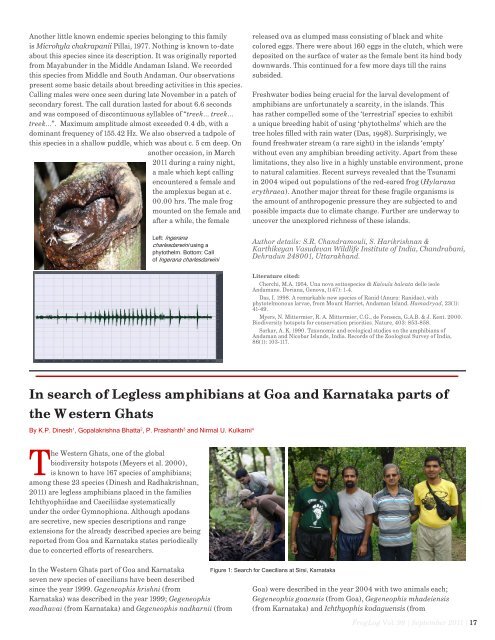download the PDF here - Amphibian Specialist Group
download the PDF here - Amphibian Specialist Group
download the PDF here - Amphibian Specialist Group
Create successful ePaper yourself
Turn your PDF publications into a flip-book with our unique Google optimized e-Paper software.
Ano<strong>the</strong>r little known endemic species belonging to this family<br />
is Microhyla chakrapanii Pillai, 1977. Nothing is known to-date<br />
about this species since its description. It was originally reported<br />
from Mayabunder in <strong>the</strong> Middle Andaman Island. We recorded<br />
this species from Middle and South Andaman. Our observations<br />
present some basic details about breeding activities in this species.<br />
Calling males were once seen during late November in a patch of<br />
secondary forest. The call duration lasted for about 6.6 seconds<br />
and was composed of discontinuous syllables of “treek… treek…<br />
treek…”. Maximum amplitude almost exceeded 0.4 db, with a<br />
dominant frequency of 155.42 Hz. We also observed a tadpole of<br />
this species in a shallow puddle, which was about c. 5 cm deep. On<br />
ano<strong>the</strong>r occasion, in March<br />
2011 during a rainy night,<br />
a male which kept calling<br />
encountered a female and<br />
<strong>the</strong> amplexus began at c.<br />
00.00 hrs. The male frog<br />
mounted on <strong>the</strong> female and<br />
after a while, <strong>the</strong> female<br />
Left: Ingerana<br />
charlesdarwini using a<br />
phyto<strong>the</strong>lm. Bottom: Call<br />
of Ingerana charlesdarwini<br />
released ova as clumped mass consisting of black and white<br />
colored eggs. T<strong>here</strong> were about 160 eggs in <strong>the</strong> clutch, which were<br />
deposited on <strong>the</strong> surface of water as <strong>the</strong> female bent its hind body<br />
downwards. This continued for a few more days till <strong>the</strong> rains<br />
subsided.<br />
Freshwater bodies being crucial for <strong>the</strong> larval development of<br />
amphibians are unfortunately a scarcity, in <strong>the</strong> islands. This<br />
has ra<strong>the</strong>r compelled some of <strong>the</strong> ‘terrestrial’ species to exhibit<br />
a unique breeding habit of using ‘phyto<strong>the</strong>lms’ which are <strong>the</strong><br />
tree holes filled with rain water (Das, 1998). Surprisingly, we<br />
found freshwater stream (a rare sight) in <strong>the</strong> islands ‘empty’<br />
without even any amphibian breeding activity. Apart from <strong>the</strong>se<br />
limitations, <strong>the</strong>y also live in a highly unstable environment, prone<br />
to natural calamities. Recent surveys revealed that <strong>the</strong> Tsunami<br />
in 2004 wiped out populations of <strong>the</strong> red-eared frog (Hylarana<br />
erythraea). Ano<strong>the</strong>r major threat for <strong>the</strong>se fragile organisms is<br />
<strong>the</strong> amount of anthropogenic pressure <strong>the</strong>y are subjected to and<br />
possible impacts due to climate change. Fur<strong>the</strong>r are underway to<br />
uncover <strong>the</strong> unexplored richness of <strong>the</strong>se islands.<br />
Author details: S.R. Chandramouli, S. Harikrishnan &<br />
Karthikeyan Vasudevan Wildlife Institute of India, Chandrabani,<br />
Dehradun 248001, Uttarakhand.<br />
Literature cited:<br />
Cherchi, M.A. 1954. Una nova sottospecies di Kaloula baleata delle isole<br />
Andamane. Doriana, Genova, 1(47): 1-4.<br />
Das, I. 1998. A remarkable new species of Ranid (Anura: Ranidae), with<br />
phytotelmonous larvae, from Mount Harriet, Andaman Island. Hamadryad, 23(1):<br />
41-49.<br />
Myers, N. Mittermier, R. A. Mittermier, C.G., de Fonseca, G.A.B. & J. Kent. 2000.<br />
Biodiversity hotspots for conservation priorities. Nature, 403: 853-858.<br />
Sarkar, A. K. 1990. Taxonomic and ecological studies on <strong>the</strong> amphibians of<br />
Andaman and Nicobar Islands, India. Records of <strong>the</strong> Zoological Survey of India,<br />
86(1): 103-117.<br />
In search of Legless amphibians at Goa and Karnataka parts of<br />
<strong>the</strong> Western Ghats<br />
By K.P. Dinesh 1 , Gopalakrishna Bhatta 2 , P. Prashanth 3 and Nirmal U. Kulkarni 4<br />
The Western Ghats, one of <strong>the</strong> global<br />
biodiversity hotspots (Meyers et al. 2000),<br />
is known to have 167 species of amphibians;<br />
among <strong>the</strong>se 23 species (Dinesh and Radhakrishnan,<br />
2011) are legless amphibians placed in <strong>the</strong> families<br />
Ichthyophiidae and Caeciliidae systematically<br />
under <strong>the</strong> order Gymnophiona. Although apodans<br />
are secretive, new species descriptions and range<br />
extensions for <strong>the</strong> already described species are being<br />
reported from Goa and Karnataka states periodically<br />
due to concerted efforts of researchers.<br />
In <strong>the</strong> Western Ghats part of Goa and Karnataka<br />
seven new species of caecilians have been described<br />
since <strong>the</strong> year 1999. Gegeneophis krishni (from<br />
Karnataka) was described in <strong>the</strong> year 1999; Gegeneophis<br />
madhavai (from Karnataka) and Gegeneophis nadkarnii (from<br />
Figure 1: Search for Caecilians at Sirsi, Karnataka<br />
Goa) were described in <strong>the</strong> year 2004 with two animals each;<br />
Gegeneophis goaensis (from Goa), Gegeneophis mhadeiensis<br />
(from Karnataka) and Ichthyophis kodaguensis (from<br />
FrogLog Vol. 98 | September 2011 | 17
















